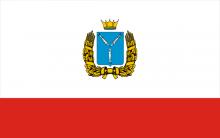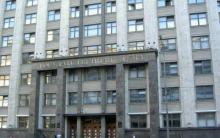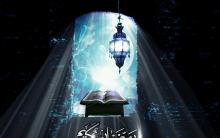So, the most picturesque red-brick buildings of the stearin factory (now Nevskaya Kosmetika) and Maxwell's manufactory (now the Rabochy factory) were left behind. left hand the space of the Neva opens. Behind the Neva, however, there is also industrial - only concrete-Soviet:
And by right hand the Proletarian plant begins - one of the three main ones in the Obukhov industrial zone:
In addition, it is the oldest in these parts - it was founded in 1824-26 as the Alexander Iron Foundry (after the name of the village of Alexandrovskoye, which was located here in those years) under the guidance of engineer Matvey Clark. In the railway era, the plant became one of the main suppliers of equipment for Russian highways - for example, in 1845 the first domestic steam locomotive was built here, and since the 1850s the production of wagons has been launched. In 1922, the plant became Proletarsky, and now its main products are ship equipment.
Buildings of the 1820s are looking at the Neva (including the director’s house in the frame above), the building of the locksmith’s workshop is a bit reminiscent of the industrial architecture of the Urals:
And the long building behind it is the purest St. Petersburg classicism. There is a version that Vasily Stasov himself, with whom Clark was friends, had a hand in these workshops. The buildings of the late 19th century (including the water tower) are all in the depths of the territory, which is even more surprising - it is quite rare for old factories to have all the most interesting things on the facade.
The Alexander Plant also had one more specialization - cast-iron fences, lattices, statues were cast here. For example, decorations of the Moscow and Narva gates, or six horses over the arch of the General Staff. A couple of lions and for themselves did not forget:
And in general, although the industrial architecture of the turn of the 18th and 19th centuries is much less spectacular than the industrial architecture of a hundred years ago, it seems to me much more interesting. Firstly, because its monuments were preserved by an order of magnitude less, and secondly, because the period from Peter the Great to Alexander the First was the "golden age" of Russian industry.
Opposite the Proletarian Palace of Culture - navigation signs. I knew that there were traffic lights for ships, but here I saw them for the first time:
The avenue finally becomes an embankment, passing along the very bank of the Neva. On the other side, Petersburg is replaced by Leningrad at the Volodarsky bridge:
Opposite - gloomy proletarian houses, either pre-revolutionary, or the 1930s:
The embankment with granite walls, forged fences, empty piers below looks very solid. But according to periskop.su , the heyday of this area fell on the 1940-60s, but for the last forty years, when life near the factories is becoming less and less popular, its degradation continues. The grass growing through the slabs of the embankment illustrates this very clearly:
Across the river there are two more very beautiful factories - the woolen manufactory "Thornton" (1844, buildings of the late 19th century):
And the paper factory of the Vargunins (the very founders of the evening school for workers, which was mentioned in the last part) - in my opinion, one of the most beautiful industrial ensembles in Russia:
A little further - Lomonosov Porcelain Factory (originally - Imperial), which I could not see in all its glory due to restoration. Meanwhile, the building of the 1780s can be mistaken for a late classicist palace. The plant was founded in 1744, and since then it has remained one of the main artistic enterprises in Russia - its products are popular among foreigners, LFZ did not live in poverty even in the 1990s. According to Periscope, the most expensive St. Petersburg porcelain is from civil war, simply because it was produced at that time very little, and each copy is a rarity.
And here is the Volodarsky Bridge - the penultimate of the Neva bridges in St. Petersburg, both in terms of location and time of construction (1985-93, on the site of the bridge of the 1930s). Behind the bridge is a "gate" with two candles from the 1970s. The Soviet architecture of Leningrad is a separate and very interesting topic:
In front of the bridge - the administration of the Nevsky district (1938-40), worthy of the House of Soviets in another area:
On the other hand, Volodarsky calls from heaven either rain or World Fire. The monument to the work of Manizer was erected in 1925, practically on the spot where Moses Goldstein (that was the real name of the revolutionary) was shot dead in 1918.
And ahead you can clearly see the River Station with a string of cruise ships that come to St. Petersburg along rivers and canals from all over European Russia. I already showed the station building itself in the post "":
Behind the motor ships, the pylons of the Bolshoi Obukhovsky Bridge are shown - the first fixed bridge across the Neva within the boundaries of St. Petersburg (opened in 2004). I will tell about it in another post, I will only say that its discovery was a breakthrough for St. Petersburg - after all, before to get from one bank to another, when the bridges were drawn, it was possible only almost through Shlisselburg.
Behind the Neva - Stalin's houses and pipes of CHPP-5:
There are two more interesting buildings around the corner:
One of the most beautiful water towers in St. Petersburg, which was part of the infrastructure of the Obukhov plant:
And the old building of CHPP-5, also known as the State District Power Plant "Utkina Zavod" (1914-1920) - one of the first power plants in St. Petersburg, stopped quite recently after almost a century of continuous operation - even part of the equipment has been preserved from the 1920s. In the photographs of past years, her building was crowned with low chimneys. The new CHPP-5 was built in the neighborhood (the first power unit was launched in 2006), and the "old woman" (as the workers themselves call this building) may be made into a museum:
A five-minute walk behind the River Station is the Color Printing Plant. Before the revolution, it was called much more interesting - the Imperial Card Factory. Built in 1817-20 as part of the Alexander Manufactory, in the 19th century it produced playing cards, the proceeds from the sale of which went to the treasury. Considering the mores of those times, when gambling among nobles and merchants was on a par with drunkenness, its profitability was probably not lower than that of iron foundries. In the 1860s, the manufactory itself was closed, and the card factory continued to operate and even acquired new buildings. They will most likely be demolished soon. I don’t know what happened to the Color Printing Combine itself: either it died, or it was rescheduled.
A little more - and we went to the Proletarskaya metro station, whose lobby seems to me one of the most interesting examples of late Soviet architecture:
From here, from "Proletarskaya", I went back to the center - but first I decided to go a little forward, where the Obukhov plant itself is located, which gave the name to the avenue. From the metro, the house of the factory boss (1810) is perfectly visible, according to other sources - the delivery yard:
And on the third - the stables of the estate of General Vyazemsky (1780s). It is very likely that just the building, which was part of the complex of the estate and two factories, changed all three functions. Almost opposite is another manor building, one of the most interesting churches in St. Petersburg - Kulich-and-Easter:
It is the Trinity Church. It was a temple in the village of Aleksandrovskoe, built according to the design of Nikolai Lvov in 1785-87. In general, Lvov was a very non-trivial architect, he owns many experiments with the form in Torzhok and Tver estates. But here he surpassed himself by building a temple in the form of two Easter dishes - a church-Kulich, an Easter bell tower ... More precisely, rather, the prototypes were much more pompous - the rotunda of the Temple of Vesta and the pyramid of Cestius in Rome, but go and explain this to the townspeople! However, after 200 years, the "gastronomic" interpretation looks much more interesting. In addition, this church is notable for the fact that Kolchak was baptized here (1874), the famous icon of the Mother of God "Joy of All Who Sorrow" "with pennies" is stored (in 1888, after a lightning strike in the church where it was kept, to her in some way 12 coins grew, which was the first of many miracles), and Kulich-and-Easter was closed only in 1938-46. So even if you are not a fan of promarche, it is worth a trip to this area.
From the church, the building of the Obukhov plant between the avenue and the Neva is already clearly visible:
The Alexander Manufactory was founded on this site by Paul the First back in 1798, and it was from it that the Card Factory grew. But as already mentioned, in 1863 the manufactory went bankrupt, and Pavel Obukhov and Nikolai Putilov founded a new factory on its site. Both of them were not only entrepreneurs, but also metallurgical engineers of the highest class, Putilov built a whole fleet of gunboats and corvettes in 1854-55 - despite the fact that before him Russia had no experience in building propeller-driven ships, and with their only owners led a hopeless war. Obukhov, with his developments in the field of weapons steel, brought the quality of Russian rifles and guns to a completely new level. In general, such people would not have built anything bad: the plant became one of the flagships of Russian metallurgy, produced parts for guns and engines, ammunition, armor, and at the beginning of the 20th century also optical instruments, almost everything for the needs of the defense industry. By 1914, more than 10 thousand people worked here, and in 1901 a strike took place at the plant, which ended in clashes with the police - the very Obukhov Defense.
Along the alley, past the Soviet buildings, we will go down to the checkpoint:
The entrance itself and one of the old workshops:
A magnificent water tower, which I first thought was an 18th century blast furnace:
A kitchen factory from the 1920s, now a bakery, faces the avenue (which is very Leningrad-like - at least three bakeries in the constructivist style have been preserved in St. Petersburg):
But most impressive, of course, is the long ribbed building of the 1890s, stretching along the avenue:
Another water tower:
As I understand it - the factory office of the 1860s:
But the factory church of the Apostle Paul (1817-26), built at the Alexander Manufactory, did not survive the Soviet era:
Here the historical industrial zone ends, although production continues further - for example, a thermal power plant, and the plant itself is stretched along the Neva for almost 2 kilometers, to the very Bolshoi Obukhovsky Bridge. We will admire the far part of the industrial zone, as well as everything already shown in these posts, in the next part from the Neva.
In the meantime, back to "Proletarskaya":
And in general, I would say that Obukhovskaya Oborona Avenue is such a dark antipode of Nevsky, its factory counterpart. Leaving Alexander Nevsky Square in different directions, two avenues clearly illustrate the two sides of the "beautiful era", one of which soon became White, and the other - Red.
CAPITAL MOLOKHI-2011
Moscow
The embankment of Prospekt Obukhovskaya Oborona is located on the left bank of the Neva. It originates from the Alexander Nevsky Bridge and stretches for 2.4 kilometers to the River Station. Today it is the only embankment in St. Petersburg with a natural outline of the banks.
The name of the embankment was the eponymous avenue overlooking this embankment. In the 18th century, a road to Arkhangelsk and Shlisselburg passed along the banks of the Neva in this area, so the locals called it Arkhangelskaya or Shlisselburgskaya. Since 1830 it was called the Shlisselburg tract. In the middle of the 19th century, Petersburg was being built, expanded, and avenues began to appear in the place where the Shlisselburg tract passed. The section that stretched from Alexander Nevsky Square to Bolshoy Smolensky Prospekt (previously called Progonny Lane) was called Shlisselburgsky Prospekt.
 |
 |
In the 30s of the 20th century, the avenue received a new name - the avenue in memory of Obukhovskaya Oborona. In 1940 - Obukhov Defense Avenue. After 12 years, the city authorities decided to unite all the avenues along the embankment and give a common name - Obukhovskaya Oborona Avenue.
Until the 20s of the last century, the slopes and banks of the embankment were not landscaped. The situation changed radically in 1926, when, according to the project of architects M.A. Orlov and V.A. Vitman and a team of engineers E.V. Tumilovich and B.D. Vasiliev, a two-tiered embankment was built on the section of the embankment between Porcelain and the Proletarian Plants. According to the plan of the architects, the lower tier was intended for the movement of goods, and the upper tier was for the walks of local residents. Today, however, both tiers are used for walking.
The embankment was lined with stone, and the descents to the water were covered with granite, numerous stair descents appeared. Observation platforms appeared along the shore, from where an amazing panorama of the river surface opened. Construction works were carried out for two years and in 1928 880 meters of the embankment were landscaped.
From 1932 to 1936 vertical walls were erected.
In 1965, a reinforced concrete wall was built between the Obvodny Canal and the Monastyrskaya River.
Among the sights of the embankment of Obukhovskaya Oborona Avenue, one can single out the Trinity Church, built according to the project of N.A. Lvov in 1975.
Its length is 11 kilometers (for comparison: Engels avenue - 10 km, Moskovsky avenue - 9.2 km, Bukharestskaya street - 8.5 km, Suzdalsky avenue - 7.7 km). In a number of areas, it is actually an embankment.
| Prospect Obukhovskoy Oborony | |
|---|---|
| Obukhovskoy Oborona Prospekt near the intersection with Olga Berggolts Street |
|
| general information | |
| Country | Russia |
| City | St. Petersburg |
| Area | Nevsky, Central |
| Length | ≈ 11 km |
| Underground | Alexander Nevsky Square-2 Alexander Nevsky Square-1 Elizarovskaya Lomonosovskaya Proletarian Rybatskoe |
| Media files at Wikimedia Commons | |
Story
On the site of the current Obukhovskaya Oborona Avenue in the 18th century, there was a postal road to Shlisselburg - Klyuch-gorod and Arkhangelsk. From 1733 until the 1830s it was called Shlisselburg road(since 1799 also Arkhangelsk road), from the 1830s - Shlisselburg tract(title Arkhangelsk tract ceased to be used in the 1880s).
In the middle of the 19th century, avenues arose on the site of the Shlisselburg tract:
- Shlisselburgsky prospect- from Alexander Nevsky Square to Progonny Lane (now part of Bolshoi Smolensky Prospekt).
- Selo Smolensky Avenue- from Progonny Lane to Moskovskaya Street (now - Krupskaya Street).
- Avenue of the Village of Michael the Archangel- from Moskovskaya street to Vladimirsky lane (now part of Farforovskaya street). In the 1930s, it was renamed Krupskaya avenue(named after N. K. Krupskaya).
- Prospect of the Village of the Porcelain Factory- from Vladimirovsky lane to a small Lesnozavodskaya street, which passes into the Kurakina road that connected the Neva with the Middle Rogatka. In the 1920s, in honor of V. Volodarsky, it was renamed into Prospect Selo Volodarskogo.
- avenue Sela Aleksandrovskogo- from Kurakina road to Church Lane (now part of Gribakin Street). May 19, 1931 renamed to Prospekt Memory Obukhovskoy Oborony, and the 1940s received modern name - Obukhovskoy Oborony Avenue.
- Prospect Derevni Murzinki- from Church Lane to modern Rybatsky Avenue.
Prospect of the Village of Aleksandrovsky, located near the former Obukhov plant (in Soviet time plant "Bolshevik"; The original name of the plant was returned in 1992 - Federal State Unitary Enterprise "State Obukhovsky Plant"), received the name Obukhovskoy Oborony Avenue in memory of the clash between the factory workers and the police on May 7, 1901, which went down in history under the name of the Obukhov Defense.
The Obukhov defense embankment is located on the left bank of the Neva in the Nevsky district of St. Petersburg. It stretches from the mouth of the Murzinka River downstream to the Monastyrka River. The embankment received its final name in 1952 in honor of the strike of the workers of the Obukhov plant in 1901.
The area in the area of Shlisselburgsky Prospekt (today's Obukhovskoy Oborony Prospekt) was rich in clays and sands suitable for the production of bricks and tiles; there were sawmills on the shore. Most of coastline passes through the factory territories, where there are sections of the fortified coast. Of the entire 10-kilometer coastline, about 2.5 km of the embankment turned out to be fortified, under the jurisdiction of the city administration.
After the Proletarian Plant, the avenue comes close to the shore. Here, in 1926-1928, the first section of the embankment arose. The high six-meter bank was turned into a two-tier embankment with stairs and a terrace. The lower tier - a cargo area 880 meters long, has a reinforced concrete banquet on a pile foundation with a circular slope, reinforced with a large stone. The second tier is a free-standing wall with large terrace with vertical granite walls opposite the main building of the Porcelain Factory. Initially, the embankment was called Farforovskaya, now it is component Embankment of the Obukhov Defense.
In 1938, during the construction of the Volodarsky bridge, adjoining sections of the embankment were built from the upstream and downstream sides with a total length of 420 meters.
In 1958, the closing wall of the embankment was built, between Farforovskaya and the embankment near the Volodarsky bridge.
In 1970, the River Passenger Station was opened. On the shore there is a wide granite terrace and a long wall of the pier. The high bank of the Neva between the pier and the wall of the embankment near the Volodarsky bridge was constantly subjected to erosion, threatening to collapse the roadbed and the tram line. In 1991, a high wall of the embankment was built, which stopped the destruction of the coast. The wall structure is a high pile grillage with prefabricated hinged blocks lined with granite.
In 1992, a part of the construction complex of the new metal Volodarsky bridge was put into operation, including the descent at the coastal support.
As for the section of the coastline enclosed between the Obvodny Canal and the Monastyrka River, it began to be strengthened as early as 1930. At the junction with the Obvodny Canal, a reinforced concrete massive embankment of the corner type was built on a wooden pile foundation. In 1960-1966, the entire area near the Alexander Nevsky bridge was improved. In addition to the construction of bridges, an embankment wall is being built to close the bank protection of this section - on a high pile grillage with prefabricated hanging blocks with granite cladding.
The location of this embankment is the left bank of the Neva. It stretched for 2.4 km from the Alexander Nevsky Bridge to the River Station.
Of the unique features of the embankment, it is worth noting the preservation of the natural outlines of the river banks. This is the only such embankment in the city. The name was given to her by the avenue facing her. From the 18th century along the Neva there was a tract called Arkhangelsk, and since 1830 - Shlisselburg. Gradually, the road ended up within the city limits, as the northern capital grew and expanded. In the middle of the 19th century avenues appeared here. One of them (between A. Nevsky Square and Bolshoi Smolensky Prospekt (formerly Progonny Lane) was named Shlisselburgsky. In the 30s-40s of the 20th century it was renamed Obukhovskoy Oborona Avenue. Subsequently, one long Obukhovskaya Oborona Avenue united in itself all the avenues that ran along the embankment.

I must say that until the 20s of the last century, this embankment was unkempt. Both the slopes and the banks did not shine with well-being and beauty. However, in 1926 a group of architects and engineers (Orlov, Vitman, Vasiliev and Tumilovich) proposed to the city authorities a project for a two-tier embankment. It was erected on the Porcelain - Proletarian Plant site. It was supposed to transport goods along the lower one, and a promenade was designed along the upper one. However, it so happened that Petersburgers chose both tiers for walking.

Stone cladding, granite stairways to the water, viewing platforms with magnificent views of the river - all this made the embankment a favorite place for citizens and guests of St. Petersburg. The work was carried out for 2 years, during which 880 m of the embankment were landscaped. In 1932-36. built vertical walls. In 1965, the Obvodny Canal and the Monastyrskaya River were separated by a reinforced concrete wall. The embankment is decorated with the Trinity Church, erected in 1975 (architect N.A. Lvov).











Beef diet dishes: cooking features
Work with a manual wood router
Do-it-yourself coal melting furnace
DIY rowing machine
Stone and brick cutting machine